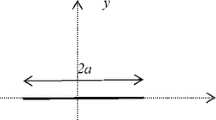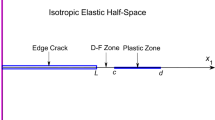We study a dislocation crack in which a displacement jump is specified at one of its tips but the faces are closed at the other tip. The physical meaning of the problem is specified from the positions of fracture mechanics for a dislocation crack, which is associated with a mathematical model of a semiinfinite defect in solid body with an introduced extra plane of given thickness and a cut on its continuation. Within the framework of this model, we deduce an integral equation and find its solution, which enables us to establish the stress-strain state near the dislocation crack. As a result, we determine the geometric parameters and find the energy of a body weakened by the dislocation crack.




Similar content being viewed by others
References
V. I. Vladimirov, Physical Nature of the Fracture of Metals [in Russian], Metallurgiya, Moscow (1984).
A. N. Stroh, “A theory of the fracture of metals,” Adv. Phys., 6, 418–465 (1957).
V. I. Vladimirov and Sh. Kh. Khannanov, “Interaction of dislocation pileups with dislocation cracks,” Fiz. Tverd. Tela, 11, No. 6, 1667–1676 (1969).
V. V. Panasyuk, A. E. Andreikiv, and V. S. Kharin, “Initiation and growth of microcracks generated by blocked dislocation pileups,” Fiz.-Khim. Mekh. Mater., 21, No. 2, 5–16 (1985).
J. Friedel, Dislocations, Pergamon Press, Oxford (1964).
J. P. Hirth and J. Lothe, Theory of Dislocations, McGraw-Hill, New York (1968).
N. G. Stashchuk, Problems of the Mechanics of Elastic Bodies with Cracklike Defects [in Russian], Naukova Dumka, Kiev (1993).
M. H. Stashchuk and M. I. Dorosh, “Determination of the geometric parameters and energy of the core of edge dislocation,” in: V. V. Panasyuk (editor), Fracture Mechanics of Materials and Strength of Structures [in Ukrainian], Karpenko Physicomechanical Institute, Ukrainian National Academy of Sciences, Lviv (2014), pp. 55–62.
S. P. Demidov, Theory of Elasticity [in Russian], Vysshaya Shkola, Moscow (1979).
Author information
Authors and Affiliations
Corresponding author
Additional information
Translated from Fizyko-Khimichna Mekhanika Materialiv, Vol. 51, No. 1, pp. 80–85, January–February, 2015.
Rights and permissions
About this article
Cite this article
Stashchuk, M.H., Dorosh, M.I. Evaluation of the Potential Energy and Geometric Sizes of a Dislocation Crack. Mater Sci 51, 88–95 (2015). https://doi.org/10.1007/s11003-015-9813-0
Received:
Published:
Issue Date:
DOI: https://doi.org/10.1007/s11003-015-9813-0




